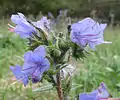Echium vulgare
Echium vulgare — known as viper's bugloss and blueweed[1] — is a species of flowering plant in the borage family Boraginaceae. It is native to most of Europe and western and central Asia,[2][3] and it occurs as an introduced species in north-eastern North America.[1][4] The plant root was used in ancient times as a treatment for snake or viper bites.[5] If eaten, the plant is toxic to horses and cattle through the accumulation of pyrrolizidine alkaloids in the liver.[6][7]
| Viper's bugloss | |
|---|---|
 | |
| Scientific classification | |
| Kingdom: | Plantae |
| Clade: | Tracheophytes |
| Clade: | Angiosperms |
| Clade: | Eudicots |
| Clade: | Asterids |
| Order: | Boraginales |
| Family: | Boraginaceae |
| Genus: | Echium |
| Species: | E. vulgare |
| Binomial name | |
| Echium vulgare | |
Description
It is a biennial or monocarpic perennial plant growing to 30–80 cm (12–31 in) tall, with rough, hairy, oblanceolate leaves.[8] The flowers start pink and turn vivid blue, and are 15–20 mm (0.59–0.79 in) in a branched spike, with all the stamens protruding. The pollen is blue[9] but the filaments of the stamens remain red, contrasting against the blue flowers. It flowers between May and September in the Northern Hemisphere.
Distribution
It is native to Europe and temperate Asia. It has been introduced to Chile,[10] New Zealand,[11] and North America where it is naturalised in parts of the continent including northern Michigan,[3] being listed as an invasive species in Washington.[12] It is found in dry, calcareous grassland and heaths, bare and waste places, along railways and roadsides, and on coastal cliffs, sand dunes, and shingle.[13]
Cultivation
E. vulgare is cultivated as an ornamental plant, and numerous cultivars have been developed. The cultivar 'Blue Bedder' has gained the Royal Horticultural Society’s Award of Garden Merit.[14][15]
Gallery
 Viper's bugloss being pollinated by skipper butterflies
Viper's bugloss being pollinated by skipper butterflies Illustration of E. vulgare
Illustration of E. vulgare Closeup of flower
Closeup of flower Viper's bugloss colonizing the banks of a Montreal city highway
Viper's bugloss colonizing the banks of a Montreal city highway White-tailed bumblebee on the blueweed
White-tailed bumblebee on the blueweed
References
- Dickinson, T.; Metsger, D.; Bull, J.; & Dickinson, R. (2004) ROM Field Guide to Wildflowers of Ontario. Toronto:Royal Ontario Museum, p. 203.
- Flora Europaea: Echium vulgare
- "Echium vulgare". Germplasm Resources Information Network (GRIN). Agricultural Research Service (ARS), United States Department of Agriculture (USDA). Retrieved 17 December 2017.
- "Echium vulgare L." Retrieved 20 August 2015.
- "Echium vulgare - Plant Finder". www.missouribotanicalgarden.org. Missouri Botanical Garden. Retrieved 19 September 2020.
- "Guide to Poisonous Plants – College of Veterinary Medicine and Biomedical Sciences". csuvth.colostate.edu. Colorado State University. Retrieved 19 September 2020.
- Klemow, Kenneth M.; Clements, David R.; Threadgill, Paul F.; Cavers, Paul B. (1 January 2002). "The biology of Canadian weeds. 116. Echium vulgare L." Canadian Journal of Plant Science. 82 (1): 235–248. doi:10.4141/P01-058.
- Graves, Melissa; Mangold, Jane; Jacobs, Jim. "Biology, Ecology and Management of Blueweed" (PDF). store.msuextension.org. Montana State University. Retrieved 22 October 2016.
- Dorothy Hodges (1952). The pollen loads of the honeybee. Bee Research Association Ltd., London.
- http://www.chileflora.com/Florachilena/FloraEnglish/HighResPages/EH0022.htm
- "Echium vulgare". New Zealand Plant Conservation Network. Retrieved 2020-11-28.
- "Common viper's bugloss: Echium vulgare (Lamiales: Boraginaceae): Invasive Plant Atlas of the United States". www.invasiveplantatlas.org. Invasive Pant Atlas of the United States. Retrieved 22 October 2016.
- Fitter, R. & A. (1974). The Wild Flowers of Britain and Northern Europe. Collins.
- "RHS Plantfinder - Echium vulgare 'Blue Bedder'". Retrieved 12 January 2018.
- "AGM Plants - Ornamental" (PDF). Royal Horticultural Society. July 2017. p. 35. Retrieved 24 January 2018.
